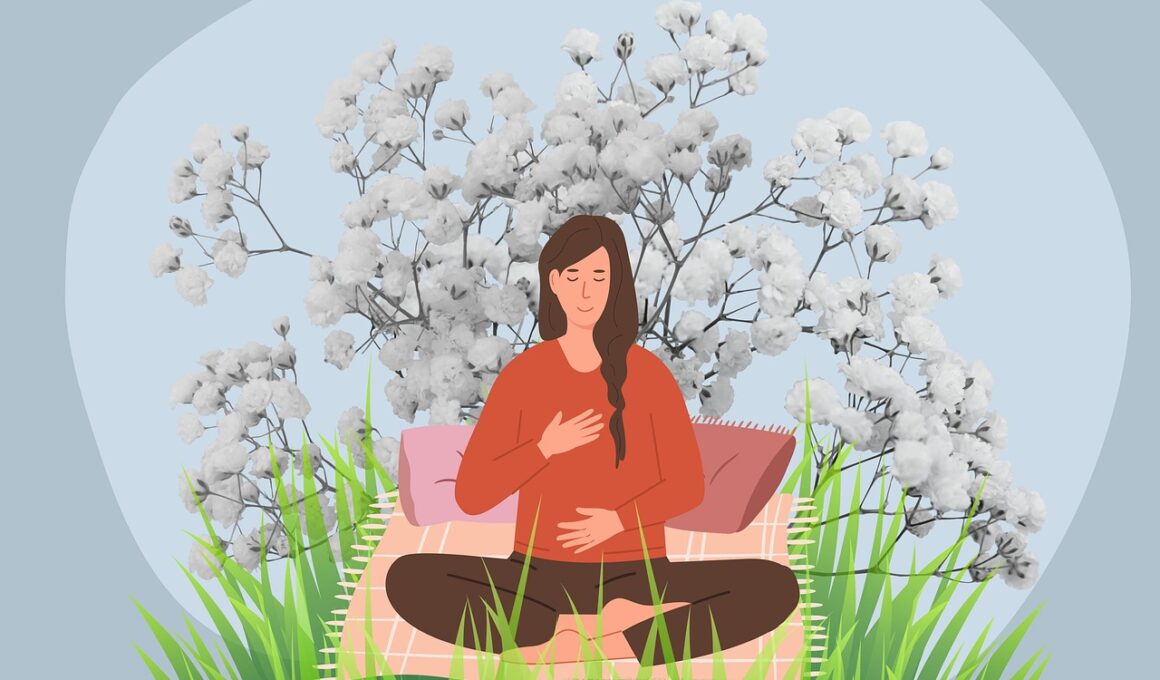Simple Breath Exercises to Boost Energy Levels in Older Adults
Breathing exercises are essential for enhancing energy levels, particularly in seniors. As we age, maintaining stamina becomes increasingly important. These exercises help improve lung function and increase oxygen supply. Enhanced oxygen flow leads to better circulation, which is vital for older adults. Consider practicing diaphragmatic breathing, which engages the diaphragm, allowing for deeper breaths. To perform this technique, sit comfortably, place one hand on your abdomen, and inhale deeply through your nose, allowing your abdomen to rise. Then, slowly exhale through pursed lips, repeating this several times. This practice can help alleviate feelings of fatigue while also contributing to relaxation. Incorporating daily sessions of breath control can not only invigorate, but also calm the mind, making them invaluable tools for active seniors. Another effective exercise is box breathing, which involves inhaling for a count of four, holding the breath for another four counts, and exhaling for four counts. This rhythmic breathing pattern promotes tranquility, making it ideal before a nap or bedtime. Regular practice of these techniques can lead to improved energy and a sense of overall well-being.
Building a consistent breathing routine can make a significant difference in energy levels. Consider setting aside specific times each day to focus on your breath. Morning sessions can provide a refreshing start, while afternoons may help combat post-lunch drowsiness. If you struggle with remembering to breathe deeply, consider using technology. Various apps can guide you through exercises, ensuring you stay committed. Often, it’s beneficial to find a quiet space conducive to relaxation. This helps you concentrate on your breath without distractions. Additionally, seniors can engage with community classes that focus on breathing techniques. These group settings provide social interaction, promoting mental health alongside physical benefits. Some individuals may also find inspiration in nature, so practicing outside can introduce fresh air and natural tranquility. Regardless of the method, the key is to listen to your body and adapt the exercises to your comfort level. As your proficiency grows, so too will your ability to harness more energy. Never forget to consult with a healthcare provider before beginning any new physical routine, especially when chronic health issues exist. This ensures a safe and effective approach to enhanced energy and vitality.
Benefits of Breathing for Seniors
Engaging in breath exercises offers numerous advantages for older adults, particularly concerning energy and vitality. Enhanced lung capacity results from regular practice, allowing for greater oxygen intake. This oxygenation is crucial for improving overall health and functionality. Additionally, better circulation ensures vital organs receive the nourishment they need. This practice can alleviate feelings of anxiety and stress, common among seniors. Stress management can also lead to better sleep patterns, contributing to a more rested state. Improved sleep can subsequently boost energy during the day, creating a beneficial cycle. Furthermore, breath control exercises can improve mental clarity by increasing oxygen supplied to the brain. Older adults may find themselves better equipped to handle daily tasks and challenges. Engaging in breathing techniques also promotes physical fitness, as improved respiratory health enables more active lifestyles. Gentle activities like walking or light stretching can be enhanced through better breath control. Moreover, social engagement, critical for mental well-being, can be improved by participating in group exercises focused on breathing. Connecting with peers while practicing these techniques can provide additional motivation and satisfaction, greatly contributing to an enriched daily life.
To further enhance the benefits of breathing exercises, seniors should be mindful of proper posture. Maintaining an upright position while practicing allows for optimal lung expansion. Consider whether you are seated or standing; both positions have their merits. Ensure that the shoulders are relaxed and the spine is straight, creating a conducive environment for deep breaths. Additionally, it can be valuable to incorporate mindfulness into breathing sessions. Combining deep breaths with a focus on the present can foster a deeper awareness of both body and mind. This practice can deepen relaxation and grounding, facilitating greater energy levels. Another effective technique is alternating nostril breathing. This technique involves closing one nostril while inhaling through the other, then switching. This can balance energy levels and calm the nervous system, making it a terrific choice if feeling overwhelmed. Visualize energy flowing freely through your body as you breathe deeply. Imagining this flow can enhance feelings of vitality and can be remarkably energizing. Regular practice of these techniques becomes a personal ritual that fosters growth and rejuvenation, helping seniors to feel their best and stay active.
Integrating Breathing Exercises into Daily Life
Integrating breathing exercises into daily routines can significantly impact energy levels. Finding specific moments throughout the day for breathwork can create a seamless practice that fits into everyday life. For instance, practitioners can pair deep breathing with ordinary activities. Waiting in line, watching television, or even during a commute can serve as reminders to utilize breath control effectively. Over time, this can lead to a heightened awareness of breathing and its importance. With practice, these moments turn into habit, becoming instinctual parts of one’s routine, enhancing overall mindfulness. Moreover, pairing breathing exercises with gentle stretches can further amplify vitality. This combination can increase blood flow, strengthen muscles, and simultaneously calm the mind. Consider pairing yoga with specific breath patterns. This blend can effectively yield the key benefits of improved energy and clarity. Seniors might also wish to set intentions for their breathing sessions. By visualizing goals, like increased energy or enhanced relaxation, individuals become more engaged in the process, enhancing its efficacy. Another useful practice is journaling post-exercise sessions, capturing how one feels after different techniques. This reflection can help in identifying the most effective methods for energizing body and mind.
Consistency is vital for the effectiveness of breathing exercises. Just as with any fitness routine, the greater the commitment, the more pronounced the result. Encourage seniors to track their progress over time. Creating a simple log of breath sessions may reveal patterns in energy levels. This documentation can serve as a motivational tool as progress becomes visible. Additionally, sharing experiences within a community or family setting can promote further practice, fostering communal support. Encourage discussions about the best techniques and feelings experienced during practice sessions. This communal reinforcement can lead to a stronger commitment to daily breath exercises. It’s essential also to recognize that variations in personal health can create different needs. Customizing exercises to one’s comfort level ensures that they remain beneficial rather than adding undue stress. Some may discover shorter, more frequent sessions work better, enabling more natural breathing rhythms throughout the day. By staying connected to how their body responds, seniors will achieve a productive breathing routine designed to boost energy effectively. As the journey continues, the balance between physical, mental, and emotional health will solidify, making a noticeable impact on their overall quality of life.
Conclusion
In conclusion, embracing simple breath exercises can transform energy levels for seniors. Consistent practice leads not only to enhanced physical endurance but also improved mental clarity. While the techniques may vary, the benefits remain consistent across the board. The key lies in finding what resonates personally. Each individual should explore various breathing patterns, documenting what feels most effective for them. Encourage loved ones to seriously consider incorporating these techniques into their daily lives regularly. Social engagement, mindfulness, and communal support can further amplify the positive impacts. Explore local classes or online resources to enhance knowledge and understanding of breath practices. Additionally, try collaborating with a healthcare team to ensure exercises align with any existing conditions. By promoting a focus on breath as an essential component of well-being, seniors can achieve newfound vitality. Breathing exercises serve as a gentle reminder that energy can be cultivated, allowing older adults to lead active and fulfilling lives. By investing time into fostering this practice, seniors create lasting improvements in both their energy levels and overall health. Ultimately, a commitment to breath not only enhances life quality but also promotes joy in daily living.
Furthermore, integrating breathing techniques into activities such as meditation or yoga allows individuals to increase benefits significantly. Practicing breath awareness during meditation promotes relaxation and assists in grounding, creating a peaceful mindset. Similarly, yoga often emphasizes breath control, making it inherently beneficial for enhancing energy levels. The link between physical activity and breath creates synergy, energizing the body and soothing the mind. Explore viable yoga classes that focus on gentle movements, ensuring comfort throughout the practice. This can foster a sense of community, encouraging consistent attendance and social interaction. Furthermore, if physical activities like yoga seem too vigorous, consider chair yoga or seated exercises to adapt movements while still harnessing breath awareness. These adapted practices can still lead to remarkable overall benefits. This adaptability is vital for seniors to continue engaging in regular exercise while minimizing the risk of injury. Remember to consult instructors about personal safety and comfort levels to promote a supportive environment suitable for practicing. Ultimately, whether seated or active, finding joy in breathwork can catalyze delightful shifts toward enhanced energy and an enriched quality of life.


